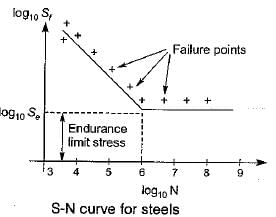Test: Design Against Fluctuating Load - 1 - Mechanical Engineering MCQ
10 Questions MCQ Test Topicwise Question Bank for Mechanical Engineering - Test: Design Against Fluctuating Load - 1
Fatigue consideration plays an important role in the design of all of the following components, except
Identify the WRONG statement about fatigue:
Which of the following process is not adopted for incresaing the fatigue strength of a material?
The endurance limit, i.e. resistance to fatigue of a machine element can be improved by
Which of the following is not exactly a property of material?
The S-N curve is the graphical representation of stress amplitude versus the number of stress cycles before the fatigue failure on a
Consider following statements about low cycle and high cycle fatigue:
1. Low cycle fatigue corresponds to stress cycle less than 1000.
2. High cycle fatigue corresponds to stress cycle more than 10000.
3. The machine components such as springs, ball bearings, gears etc. are subjected to high cycle fatigue.
4. A greater factor of safety is taken in low cycle fatigue to ignore the fatigue effect.
Which of the above statements are valid?
Increase of actual stress over nominal stress due to stress raising notches in fatigue loading is given by
Which of the following approximate relationship between the endurance limit and the ultimate tensile strength of the material based on 50% reliability is not correctly matched?
Stress concentration in a machine components results'from:
1. abrupt changes in the cross-section of the component.
2. pressure at points/areas of the component at which the load is applied.
3. point-to-point variation in the properties of the material of the component.
Which of the above statements are valid?
|
45 videos|314 tests
|




















